I have seen a few people posting online about their attempts at a pineapple hard cider recipe and it sounded interesting so I thought I would give it a shot. I am a big fan of pineapple (especially on pizza) and obviously love apples but I was a little skeptical on how they would turn out when fermented together.
The only fermented pineapple drink I have had was Tepache when I was in rural Mexico. Traditional Tepache is a naturally fermented beverage based with pineapple with brown sugar cinnamon and cloves. The flavorful drink is one of the most popular street beverages in Mexico.
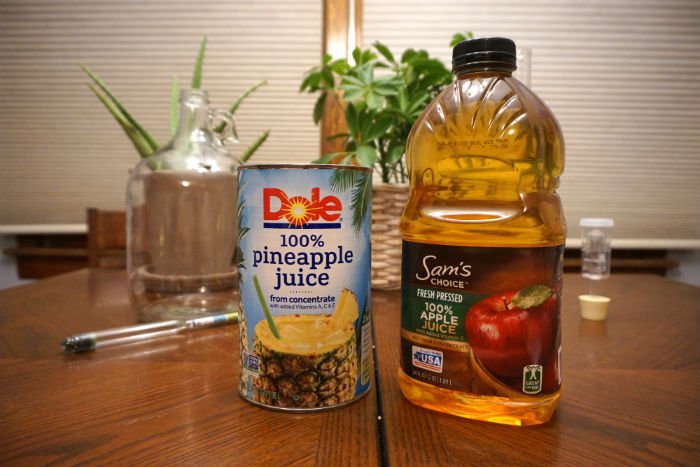
Thinking back to that Tepache in Mexico gave me hope when I began to blend the apple and pineapple juice in the fermenter. The pineapple juice mixed with the apple and made a bright orange opaque solution with a sweet tropical scent.
I took a hydrometer reading and found the original gravity to be 1.050 SG. Since planned to use an ale yeast that will finish hopefully around 1.005, I estimated the apple pineapple cider would have a final ABV of approximately 5.9%. I thought about chaptalizing with apple juice concentrate to raise the original gravity but decided to keep it simple for the first batch.
Pineapple Cider Recipe Ingredients:
Juice Selection:
I chose a commercially produced apple juice and pineapple juice. I decided to stick with commercially produced juices because they tend to be blended and balanced so I know what I am starting with and can reproduce it. Once I find a good recipe, I will then try it with fresh pressed juice.
Yeast Selection:
I chose to use an ale variety yeast, Nottingham, which finishes semi-sweet and adds notes of fruity flavors that compliment the pineapple and apple cider well.
Yeast Nutrient:
The yeast nutrient and energizer will improve the health of the yeast which will produce finer tasting alcohol (fewer fusel alcohols ). When making a cider, yeast nutrient or DAP, is typically added in the beginning to increase the amount of dissolved nitrogen in the juice.
Five Essential Pieces of Equipment





How to Make Pineapple Cider:
Preparing the Recipe for Fermentation:
- Clean and sanitize all equipment
- Pour the apple and pineapple juice into the fermenter
- Mix the juices thoroughly, don’t worry about introducing oxygen at this point
- Take a hydrometer reading of the fresh must
- Add 1 tsp. yeast nutrient to the fermenter
- Pitch the yeast and attach the airlock
Hydrometer & ABV Info:
Original Gravity: 1.050 SG
Target Final Gravity: 1.005 SG
Expected ABV: 5.9%
Fermentation:
Nottingham yeast tolerates temperatures between 50F-72F but I like to ferment at about 68F. Once the yeast was pitched, the sweet apple and pineapple juice didn’t take long to begin fermenting. The yeast acted quickly and within about 8 hours I began to notice a krausen layer forming on the surface.
Within about 24 hours the fermenter was almost full of foam so I switched the airlock out for a blow off tube. Shortly after, the ferment began to blow off so I degassed the cider by gently swirling the fermenter multiple times to help relieve some of the CO2. After two days, the foam receded and I switched back to a three piece airlock.
Only 5 days into the fermentation process, airlock activity started to slow and eventually came to a stop after a little over a week.
Finishing the Pineapple Cider:
Once fermentation completely stopped, I placed the one gallon carboy into the refrigerator to cold crash so the yeast and other solids such as fruit pulp can settle to the bottom. Then, I racked the pineapple cider into a different clean and sanitized carboy so the cloudy pineapple would have more time to clear.
After a couple of days of cold crashing, the pineapple hard cider didn’t clear up much but I did notice a fair amount of sediment fall out. At this point, I decided to finish up the batch by racking it into a half gallon growler, a single bottle and left the rest for hydrometer testing and tasting.
New to Cider Making? Check out the guide!
Thoughts on Taste
The pineapple hard cider finished drier than I had expected although it was still packed with pineapple and fruity flavors. I immediately noticed the pineapple aroma as soon as I started to pour some off into the hydrometer test cylinder and really enjoyed it when I went in for a sip.
The final specific gravity of the pineapple cider was right about 1.000 SG so the estimated ABV was about 6.55%. The flavor of alcohol was definitely present although it was not unpleasant and the fruity flavor still shined. I am curious to see what a couple of months of age will do to this batch!
Next time I will try to ferment the apple cider fully and then add the pineapple in the secondary, or back sweeten and keg to see what else is possible.
Overall, I am very happy with the initial results and will definitely be experimenting more with this recipe!
Pineapple Hard Cider Recipe
Materials
- 82 oz Apple Cider
- 46 oz Pineapple Juice
- 1 pack Nottingham Ale Yeast
- 1 tsp Yeast Nutrient
Instructions
- Clean and sanitize all cider making equipment before starting.
- Pour the Apple and Pineapple juices into the fermenting vessel.
- Take a hydrometer reading to measure the gravity.
- Add the yeast nutrient if desired.
- Add the yeast to the fermenter.
- Install the airlock on the fermented and fill with sanitizer.
- Allow the cider to ferment in a cool and dark place for about two weeks.
- Cold crash, rack and bottle.
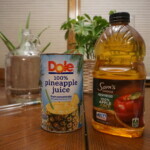
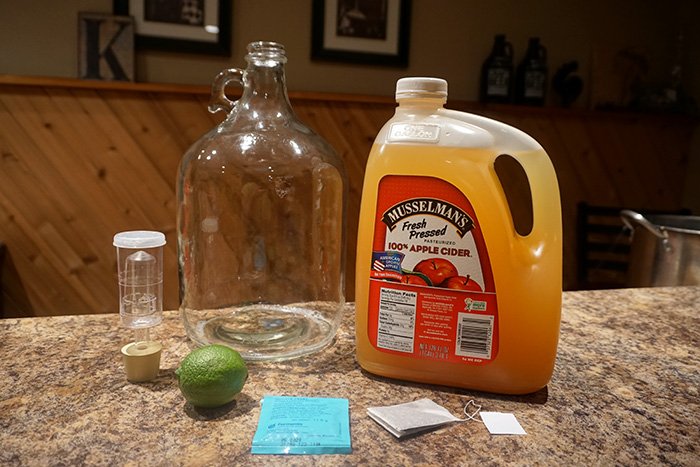
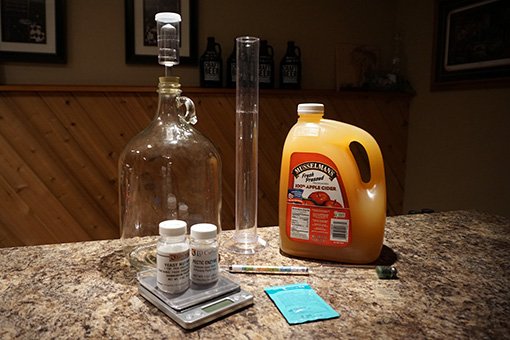
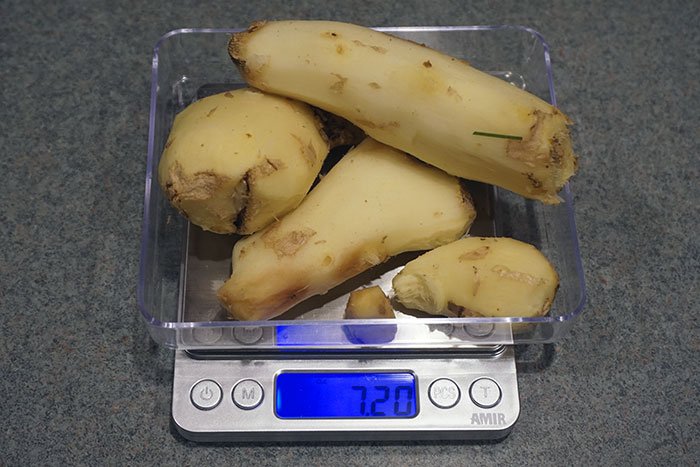
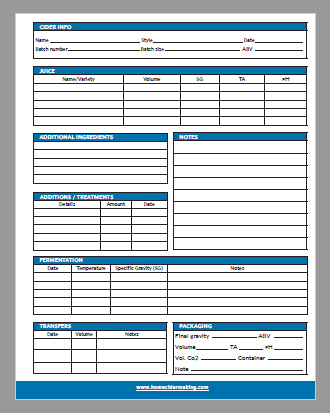
hello, I would like to make a pineapple cider and have it a sweeter one than the apple cider I made last month. If you found that your pineapple wasn’t as sweet as you thought……how would you back sweet it?
HI Elizabeth,
To backsweeten this recipe I would either add apple juice concentrate or pineapple juice in the secondary after the cider has been fermented and stabilized. It wouldn’t take much and I think a little extra sweetness would be perfect.
At first it was sharp so we added three cans of apple juice concentrate to the thee gallon carboy and it was fantastic.
I have had some success with the following,
2 Gallons pineapple juice
3 Gallons apple juice
2 Pounds of light brown sugar
1 packet SA-04
Combine in a 6.5 Gallon Carboy, with blow off hose inserted until initial fermentation slows then air locked. Allow to ferment until clear. Bottle with 5 oz priming sugar and back sweetened to taste with Splenda.
I would like to make a 20 liters batch of this cider. Thats about 5,8 gallons. Do you think there is a big risk of endig up with 20 liters of undrikable cider? Btw, do you bottle and carbonate og is this one better without co2?
Any advice on the way?
Hi Andreas,
Sorry for the late response.
This recipe can easily be multiplied, there is no issue with going to a 20L batch. Also, I don’t think there is a risk of making it undrinkable, just make sure you hit the OG you are looking for so you end up with the right ABV.
If it doesn’t turn out exactly as you planned, tweak the recipe and give it another shot. That’s the fun of experimenting!
Even if you don’t really love it, I’m sure you can find a friend that will. We all have different taste!
Cheers!
How long all start to finish did this recipe take excluding aging?
Once it is bottled after finishing what is best way to store hard cider? Refrigeration or could it be kept like in a cool dark basement ?
Can I use a sparkling wine yeast? I’s all they had at my local shop.
Also, can I add dextrose to bring up the OG? ..thanks.
Yes to both although it’s fun to use another fermentable (besides Dex) like honey or brown sugar to do that.
I’ve tried this recipe twice. Both times the yeast didn’t bubble (burp or activate). Any ideas?
You can use some warm water ( distilled or tap but make sure there is NO chlorine from municipal water ) add some brown sugar. 1 tblspoon in a cup of warm water then add the yeast. Not HOT just warm. Heat and chlorine will kill the yeast. Heat will neutralize bleach. I wonder if the acid stopped the yeast from functioning or if the yeast was NOT fresh and active . You can buy yeast in a foil pack that you rupture inside the foil so yeast does what I just suggested. It lets yeast get started before pitching it into your wort ( un fermented beer or cider) once the yeast can get started it will have lots more active yeast ready to eat the sugar and make Co2 and Alcohol
I make Pineapple cider right in the food grade jugs you buy it in at the grocery store. I also make it in the crystal springs 1 gallon water bottles ( food grade clear plastic) I just use champagne yeast from brewing store. Pineapple alone is excellent. Apple blend is good. I just add little sugar when serving it. I have made lots of home brew. Cider is much easier. I usually harvest some or most then just add more juice. I don’t worry about the gravity. It’s excellent. For apple cider add a little fireball over ice to enjoy apple pie cocktails. Good luck